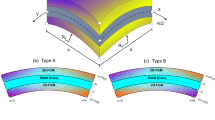Abstract
In this study, we piesent a new efficient hybrid-mixed composite laminated curved beam element The present element, which is based on the Helhnger-Reissnet vatiational principle and the first-order shear deformation lamination theory, employs consistent stress parameters coriespondmg to cubic displacement polynomials with additional nodeless degrees in order to lesolve the numerical difficulties due to the spurious constraints The stress parameters are eliminated and the nodeless degrees are condensed out to obtain the (6X6) element stiffness matrix The present study also incorporates the straightforwaid prediction of interlaminar stresses from equilibrium equations Seveial numencal examples confirm the superioi behavior of the present composite laminated curved beam element
Similar content being viewed by others
References
Ashwell, D. G. and Sabir, A. B. 1971. “Limitations of Certain Curved Beam Elements When Applied to Arches.”Internal. J. Mech. Sci, Vol. 13, pp. 133–139.
Cook, R. D. Malkus, D. S. and Plesha, M E., 1989,Concepts and Applications of Finite Element Analysis. 3rd Edition.Wiely, New York.
Dawe, D. J. 1974, “Numerical Studies Using Circular Arch Finite Elements.”Computers &Structures, Vol. 4. pp. 729–740.
Dorfi, H. R. and Busby, H. R. 1994.“An Effective Curved Composite Beam Finite Element Based on the Hybrid-Mixed Formulation.”Computers & Structures. Vol. 53. pp. 43–52.
Kant, T. and Manjunath, B. S. 1959. “Refined Theories for Composite and Sandwich Beams with C° Finite Elements.”Computers & Structures. Vol. 33. No. 3, pp. 755–764.
Kim, J. G. and Kim, V. V. 1998. “A New Higher-Order Hybrid-Mixed Curved Beam Element.”International Journal for Numerical Methods in Engineering Vol.43, pp. 925–940.
Kim, J. G. and Kang, S. W. 2003.“A New and Efficient C° Laminaied Curved Beam Element.”Transactions of the KSME, A. Vol. 27 No. 4. pp. 559–566.
Kim, J. G. 2000. “Optimal Interpolation Functions of 2-Node Hybrid-Mixed Curved Beam Element.”Transactions of the KSME, A. Vol. 24. No. 12. pp. 3003–3009.
Levinson, M., 1981.“A New Rectangular beam theory,”Journal of Sound and Vibration. Vol.74. pp. 81–87.
Levinson, M. 1981. “Further Results of a New Beam Theory,”Journal of Sound and Vibration. Vol 77, pp 440–444
Moon, W J, Kim, Y W, Min, O K and Lee, K W 1996, “Reduced Minimization Theory in Skew Beam Element,”Transactions of the KSME, Vol 20, No 12, pp 3702–3803
Noor, A K and Peteis, J M, 1981, “Mixed Models and Reduced/Selective Integration Displacement Models for Nonlinear Analysis of Curved Beams,”International Journal for Numerical Methods in Engineering, Vol 17, pp 615–631
Pagano, N J, 1969, “Exact Solutions for Composite Laminates in Cylindrical Bending,”Journal of Composite Materials, Vol 3, pp 398–411
Plan, T H H and Chen, D, 1983, “On the Suppression of Zero Energy Deformation Modes,”International Journal for Numerical Methods in Engineering, Vol 19, pp 1741–1752
Prathap, G and Babu, C Ramesh, 1986, “An Isoparametric Quadratic Thick Curved Beam Element,”International Journal for Numerical Methods in Engineering, Vol 23, pp 1583–1600
Prathap, G, 1993,The Finite Element Method in Structural Mechanics, Kluwei, Dordrecht
Rychter, Z, 1987, “On the Accuracy of a Beam Theory,”Mechanics Research Communication, Vol 14, pp 99–105
Ryu, H S and Sin, H C, 1996,“A 2-Node Strain B ased Cuived Beam Element,”Transactions of the KSME, A, Vol 18, No 8, pp 2540–2545
Saleeb, A F and Chang, T Y, 1987, “On the Hybrid-Mixed Formulation C° Curved Beam Elements,”Computer Methods in Applied Mechanics and Engineering, Vol 60, pp 95–121
Stephen, N G and Levinson, M, 1979,“A Second Order Beam Theory,”Journal of Sound and Vibtation, Vol 67, pp 293–305
Stolarski, H and Belytschko, T, 1983,“Sheat and Membrane Locking in Curved Elements,”Computer Methods in Applied Mechanics and Engineering, Vol 41, pp 279–296
Stolarski, H and Belytschko, T, 1982, “Membrane Locking and Reduced Integration for Curved Elements,”Journal of Applied Mechanics, Vol 49, pp 172–176
Vinson, J R and Sierakowski, R L, 1986,The Behavior of Structures Composed of Composite Materials, Martinus Nijhoff, Dordrecht
Washizu, W, 1986,Variational Methods in Elasticity and Plasticity, 3rd Ed, Pergamon Piess, Oxfoid
Author information
Authors and Affiliations
Corresponding author
Rights and permissions
About this article
Cite this article
Lee, HC., Kim, JG. A new hybrid-mixed composite laminated curved beam element. J Mech Sci Technol 19, 811–819 (2005). https://doi.org/10.1007/BF02916129
Received:
Revised:
Issue Date:
DOI: https://doi.org/10.1007/BF02916129




